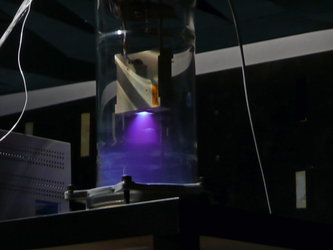Accept all cookies Accept only essential cookies See our Cookie Notice

About ESA
The European Space Agency (ESA) is Europe’s gateway to space. Its mission is to shape the development of Europe’s space capability and ensure that investment in space continues to deliver benefits to the citizens of Europe and the world.
Highlights
ESA - United space in Europe
This is ESA ESA facts Member States & Cooperating States Funding Director General Top management For Member State Delegations European vision European Space Policy ESA & EU Space Councils Responsibility & Sustainability Annual Report Calendar of meetings Corporate newsEstablishments & sites
ESA Headquarters ESA ESTEC ESA ESOC ESA ESRIN ESA EAC ESA ESAC Europe's Spaceport ESA ESEC ESA ECSAT Brussels Office Washington OfficeWorking with ESA
Business with ESA ESA Commercialisation Gateway Law at ESA Careers Cyber resilience at ESA IT at ESA Newsroom Partnerships Merchandising Licence Education Open Space Innovation Platform Integrity and Reporting Administrative Tribunal Health and SafetyMore about ESA
History ESA Historical Archives Exhibitions Publications Art & Culture ESA Merchandise Kids Diversity ESA Brand CentreLatest
Space in Member States
Find out more about space activities in our 23 Member States, and understand how ESA works together with their national agencies, institutions and organisations.
Science & Exploration
Exploring our Solar System and unlocking the secrets of the Universe
Go to topicAstronauts
Missions
Juice Euclid Webb Solar Orbiter BepiColombo Gaia ExoMars Cheops Exoplanet missions More missionsActivities
International Space Station Orion service module Gateway Concordia Caves & Pangaea BenefitsLatest
Space Safety
Protecting life and infrastructure on Earth and in orbit
Go to topicAsteroids
Asteroids and Planetary Defence Asteroid danger explained Flyeye telescope: asteroid detection Hera mission: asteroid deflection Near-Earth Object Coordination CentreSpace junk
About space debris Space debris by the numbers Space Environment Report In space refuelling, refurbishing and removingSafety from space
Clean Space ecodesign Zero Debris Technologies Space for Earth Supporting Sustainable DevelopmentLatest
Applications
Using space to benefit citizens and meet future challenges on Earth
Go to topicObserving the Earth
Observing the Earth Future EO Copernicus Meteorology Space for our climate Satellite missionsCommercialisation
ESA Commercialisation Gateway Open Space Innovation Platform Business Incubation ESA Space SolutionsLatest
Enabling & Support
Making space accessible and developing the technologies for the future
Go to topicBuilding missions
Space Engineering and Technology Test centre Laboratories Concurrent Design Facility Preparing for the future Shaping the Future Discovery and Preparation Advanced Concepts TeamSpace transportation
Space Transportation Ariane Vega Space Rider Future space transportation Boost! Europe's Spaceport Launches from Europe's Spaceport from 2012Latest

Polish space thruster
Thank you for liking
You have already liked this page, you can only like it once!
This prototype Polish-built plasma thruster is shown during test firing within an airless chamber at ESA’s Propulsion Laboratory.
Designed and built by Poland’s Institute of Plasma Physics and Laser Microfusion (IFPiLM), this is the country’s first space thruster.
Weighing 4 kg and 12 cm in length, it is a ‘Hall effect’ thruster, accelerating the ionised propellant with a magnetic field, boosting thrust compared to traditional designs.
It is designed to maintain or change the orbits of low-orbiting small satellites, including compensating for drag from the top of the atmosphere.
Such thrusters typically employ the noble gas xenon for fuel, but this design can also operate with cheaper krypton.
Testing took place inside a 4 m by 2 m vacuum chamber in the Agency’s ESTEC technical centre in Noordwijk, the Netherlands. The instrumented chamber is equipped to measure thrust down to the millinewton scale as well as gathering precise voltage and current levels.
Poland joined ESA at the end of 2012. The IFPiLM prototype was first tested at ESTEC last November, as part of ESA’s Plan for European Cooperating States (PECS) agreement signed with Poland. Two follow-up test campaigns are planned for later this year and 2015.
In operation for the last two decades, ESTEC’s ISO-certified Propulsion Laboratory specialises in electric propulsion systems, as well as some types of chemical propulsion. Its expertise includes micropropulsion testing and endurance firings, assessing thruster performance over hundreds or thousands of hours of operation.
-
CREDIT
IFPiLM -
LICENCE
ESA Standard Licence

Prototyp silnika plazmowego

Prototyp silnika plazmowego

Greener way to get satellites moving

CubeSat micro-pulsed plasma thruster















 Germany
Germany
 Austria
Austria
 Belgium
Belgium
 Denmark
Denmark
 Spain
Spain
 Estonia
Estonia
 Finland
Finland
 France
France
 Greece
Greece
 Hungary
Hungary
 Ireland
Ireland
 Italy
Italy
 Luxembourg
Luxembourg
 Norway
Norway
 The Netherlands
The Netherlands
 Poland
Poland
 Portugal
Portugal
 Czechia
Czechia
 Romania
Romania
 United Kingdom
United Kingdom
 Slovenia
Slovenia
 Sweden
Sweden
 Switzerland
Switzerland

























